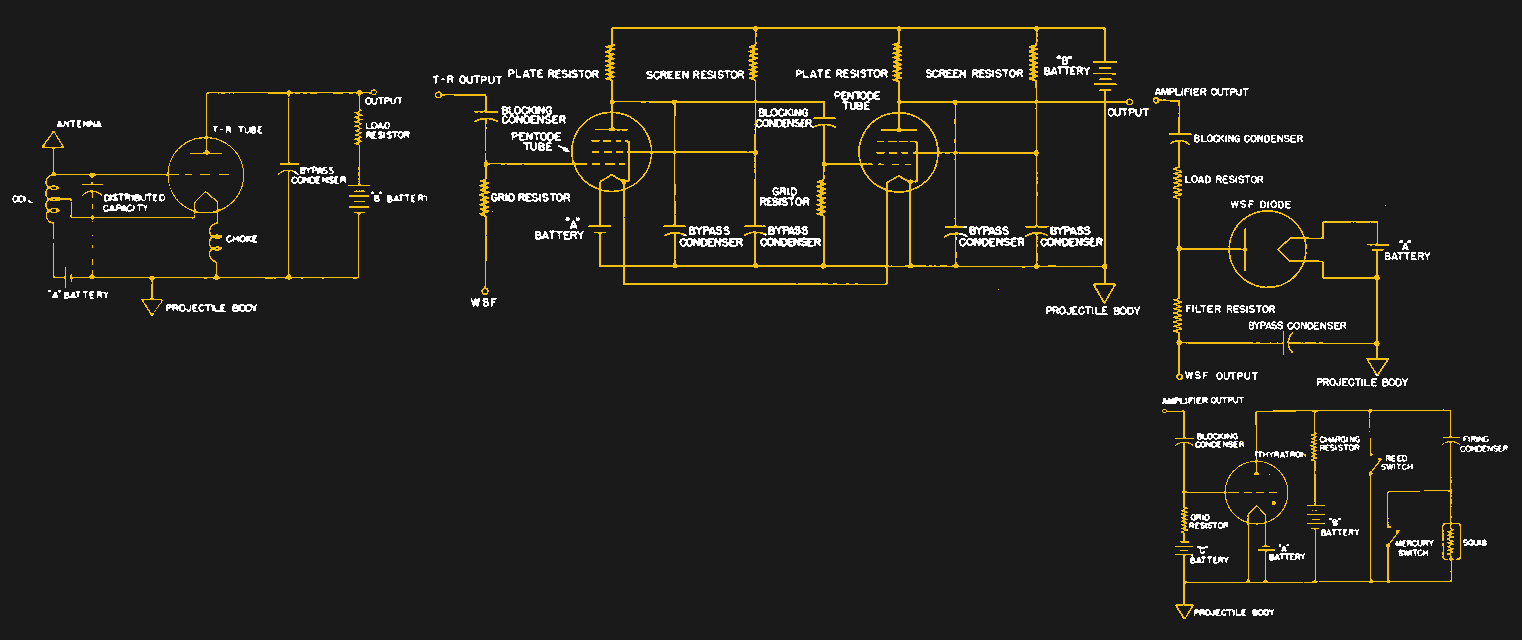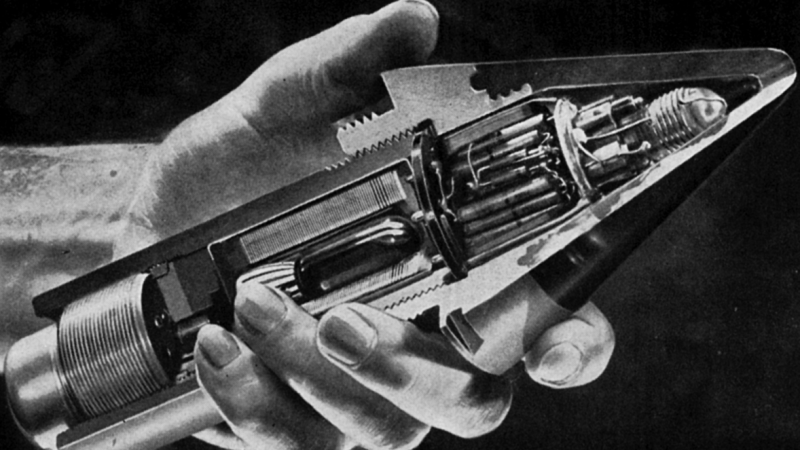Here at Hackaday, our aim is to bring you only the freshest of hacks, which carries the burden of being Johnny-on-the-spot with our source material. So if something of obvious interest to our readers goes viral, we might just choose to skip covering it ourselves, figuring you all have probably seen it already. But, if we can dig a little deeper and bring extra value over and above what the viral content provides — well then that’s another story.
That’s pretty much the story behind the excellent video recently released by [Real Engineering] about “The Secret Weapon That Changed World War 2.” It concerns the VT series of proximity fuzes — it’s a legitimate alternate spelling of “fuse” if a somewhat archaic one — that were used for artillery shells and spin-stabilized rockets in World War II. The video gives an excellent overview of the development of the VT, which was used primarily in anti-aircraft artillery (AAA). The details about the development of the American VT fuze are excellent, although curiously there’s no mention that British experiments with a radio proximity fuze were part of the goldmine of information brought to America at great risk by the Tizard mission in 1940. While there has been plenty of contention about the exact role the British work played, it’s fair to say that it at least informed the development and fielding of the American VT fuze.
The Deep(er) Dive
As for how the fuze worked, the video goes into a slightly less than satisfying degree of detail. That’s not a complaint, as too much detail in that department would likely not appeal to a broad audience. But for the Hackaday set, more detail is better, so I set about learning what made the VT fuze tick. As a radio proximity fuze, the basic concept is obvious — generate a strong RF pulse and listen for any signals that may have been reflected by a nearby solid object, such as an airplane. But the devil’s in the details, as they say, and the challenges involved with getting this to work under battlefield conditions were immense.
So what kind of circuits were used to make all this work? And how did circa-1940 electronics survive the 20,000-g loads experienced by the fuze as the artillery shell is fired? Although a lot of details aren’t available, the 1946 Bureau of Ordinance VT fuze manual reveals a lot of details, including schematics. Unfortunately, there’s no overall schematic given, so I had to stitch together one from the fragments given in the manual:

The heart of the VT fuze is a one-tube transmitter-receiver, shown in the upper left of the schematic. It’s described in the manual as a “grounded-grid Hartley oscillator,” although with notes that Navy versions of the VT used a modified Colpitts oscillator. The single triode acted as both oscillator to transmit the RF signal and a detector for the reflected signal. No component values are given in the manual, so it’s hard to estimate the frequency the VTs used, but since these were mostly designed to detect airplanes, we’d guess a minimum wavelength of above the size of a plane, perhaps 5 to 10 meters, or between 28 to 60 MHz or so. This seems like a reasonable frequency for the circuits shown, and for the antenna, which is described as a “standard dipole.”
Getting the Beat
At the end of the day, though, the actual transmitter frequency isn’t of much concern, because detection is based on the difference in frequency between the transmitted frequency and the reflected signal, and the beat frequency generated thanks to the fact that the range between the shell and the target is rapidly changing, The video does a great job of explaining this, and the manual details how the amplifier circuit (top center in the schematic above) accomplishes this. I’ve never had much luck understanding vacuum tube circuits, so I’ll leave it to better minds than mine to detail the theory here, but suffice it to say that proper selection of components in the amplifier circuit, particularly the screen and plate bypass capacitors, creates a filter whose center frequency corresponds to that expected when the target is within the effective blast radius of the shell. When that happens, the gas in the thyratron in the firing circuit (lower right) is ionized, allowing the fully charged firing capacitor to discharge through a squib and detonate the shell.
For naval use, a wave-suppression circuit (upper right) was added. “Wave” referred to ocean waves, not radio waves, which could reflect the transmitted signal and cause early detonation of a shell when fired at a low angle of elevation, as when an enemy torpedo bomber approached. The WSF essentially decreases the sensitivity of the amplifier in the presence of a steady signal, which can occur as the shell travels over the waves.
As with most military inventions, the VT fuze was fiendishly clever. That 1940s technology was able to come up with a circuit that was small enough to fit on an artillery shell, durable enough to survive the brief trip to the target, and cheap enough to be manufactured in bulk — the cost per unit had dropped as low as $18 by 1945 — is a testament to the ingenuity of the engineers involved.

















Still blows my mind that they made vacuum tubes capable of surviving cannon gee forces reliably. Obviously it works, but it really doesn’t seem like it should
I think I remember seeing an image where the shell nose internals were separated into two halves and worked on capacitance somehow, far less sophisticated than the one described.
Didn’t watch the video, but lots of details here:
12 Seconds Of Silence: How a Team of Inventors, Tinkerers, and Spies Took Down a Nazi Superweapon
by Jamie Holmes
And the fuse would not have happened without US engineering, everyone else thought that a vacuum tube that could withstand 20,000G acceleration was impossible to design.
Today you can buy tiny cheap optical or infrared Time-of-Flight (ToF) sensors that can form the basis of an nice high-G proximetry fuse. These should get you started:
1. ST Microelectronics – Time-of-Flight sensors
https://www.st.com/en/imaging-and-photonics-solutions/time-of-flight-sensors.html
2. ams-OSRAM AG – Time-of-Flight sensors
https://ams.com/time-of-flight
3. Texas Instruments – Time of flight (ToF) sensors
https://www.ti.com/sensors/specialty-sensors/time-of-flight/products.html
I feel like I violated ITAR just by reading your comment.
Same here. I thought “oh crap now i’m on a list for clicking on this article”, but now i know I stumbled onto so much more lol
The last time I used one the polling rate left a lot to be desired. You would have to have a dozen on the end of your nerf-artillery shell to make it deploy reliably.
The Tizard mission brought the Cavity Magnetron which was not used by the VT fuse. The development of the CM range radar was an interesting partnership. The US had developed a good receiver but had not found a good transmitter. The Brits had a good transmitter but lacked a receiver. Then RCA figured out how to mass produce the Magnetron. They replaced precision machining with stamping.
For some reason the US’s developments during WWII are overlooked except for the rapid production and the Atomic Bomb.
There was much more in the trunk than just the magnetron.
You’re saying they had a lot of Junk in their Trunk?
“Fuze” isn’t an alternate or archaic spelling of “fuse”; it’s a different technical term. To quote Wikipedia:
Some professional publications about explosives and munitions distinguish the “fuse” and “fuze” spelling.[5][6] The UK Ministry of Defence states (emphasis in original):
Fuse: Cord or tube for the transmission of flame or explosion usually consisting of cord or rope with gunpowder or high explosive spun into it. (The spelling fuze may also be met for this term, but fuse is the preferred spelling in this context.)[7]
Fuze: A device with explosive components designed to initiate a main charge. (The spelling fuse may also be met for this term, but fuze is the preferred spelling in this context.)
What I found most interesting was the details of how it was powered/armed. The battery was installed dry (as battery shelf life those day was months) and a vial of electrolyte was broken by the forces of the spinning shell (50k rpm). The same forces distributed the liquid to the cells that surrounded it.
As for understanding the tube circuit, just substitute a N-channel JFET for the triode. (Yes, I know this doesn’t help with tetrodes/pentodes/pentagrids, but it’s a start.)
George O. Smith, who wrote the ‘Venus Equilateral’ series of stories about a (manned) comsat in a Trojan orbit with Venus to overcome communications failure when the planet passed behind the Sun, was an engineer on the proximity fuze project.
Those tiny valves are amazing. The hearing aid origin was fascinating too.
I know its picky but when you refer to ordnance in the weapons sense, it is spelled without an “I”. Ordinance is a city law or statute.
Deke Parsons helped build the fuse. Some of the history is amazing.
https://www.amazon.com/Target-Hiroshima-Parsons-Creation-Atomic/dp/1612514928
Highly recommend this book.